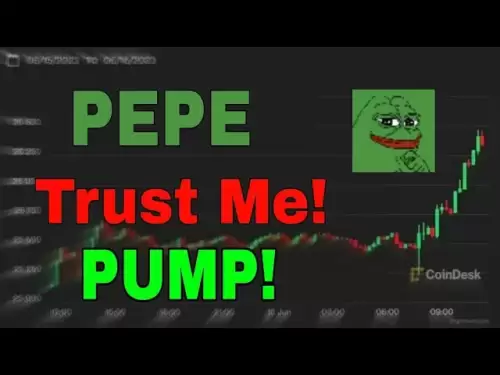-
 Bitcoin
Bitcoin $104,977.2024
-0.79% -
 Ethereum
Ethereum $2,618.2067
-0.03% -
 Tether USDt
Tether USDt $1.0004
-0.02% -
 XRP
XRP $2.2090
-2.35% -
 BNB
BNB $666.7281
-0.15% -
 Solana
Solana $154.0605
-2.14% -
 USDC
USDC $0.9997
-0.02% -
 Dogecoin
Dogecoin $0.1896
-3.18% -
 TRON
TRON $0.2726
1.32% -
 Cardano
Cardano $0.6727
-3.66% -
 Hyperliquid
Hyperliquid $35.7697
-3.19% -
 Sui
Sui $3.1869
-2.98% -
 Chainlink
Chainlink $13.8494
-3.59% -
 Avalanche
Avalanche $20.1630
-6.35% -
 Stellar
Stellar $0.2677
-2.75% -
 UNUS SED LEO
UNUS SED LEO $8.9617
-0.61% -
 Bitcoin Cash
Bitcoin Cash $401.1624
-0.76% -
 Toncoin
Toncoin $3.1899
-0.55% -
 Shiba Inu
Shiba Inu $0.0...01289
-1.80% -
 Hedera
Hedera $0.1683
-2.98% -
 Litecoin
Litecoin $88.8825
-1.89% -
 Polkadot
Polkadot $4.0342
-3.77% -
 Monero
Monero $318.8920
-8.69% -
 Ethena USDe
Ethena USDe $1.0011
-0.02% -
 Bitget Token
Bitget Token $4.7273
-2.13% -
 Dai
Dai $0.9998
-0.02% -
 Pepe
Pepe $0.0...01196
-3.71% -
 Pi
Pi $0.6483
-0.29% -
 Aave
Aave $264.4624
-0.45% -
 Uniswap
Uniswap $6.3144
-5.66%
What are Meme coins/governance coins/utility coins in blockchain? Analysis of token types
Meme coins rely on social media buzz, governance coins enable decision-making in DAOs, and utility coins facilitate access to blockchain services, each serving unique roles in crypto ecosystems.
Jun 02, 2025 at 10:43 am
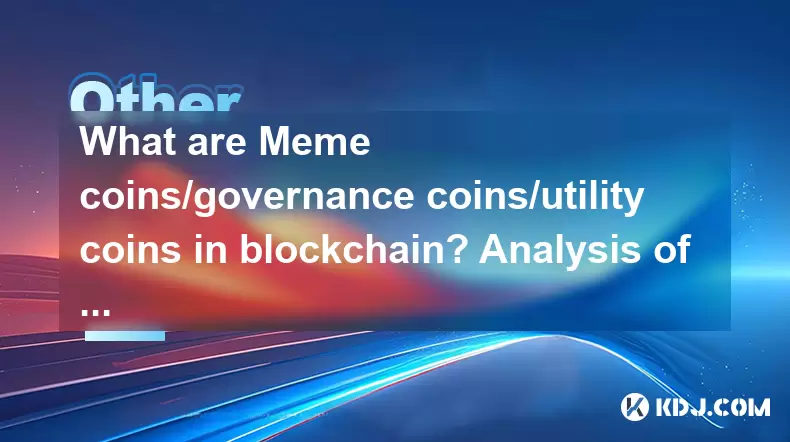
In the world of blockchain and cryptocurrencies, tokens play a pivotal role in facilitating various functions and interactions within their respective ecosystems. Understanding the different types of tokens—meme coins, governance coins, and utility coins—is essential for anyone looking to navigate this complex landscape. This article will delve into the specifics of each token type, providing a detailed analysis of their characteristics, uses, and significance within the cryptocurrency circle.
Meme Coins
Meme coins are a unique category of cryptocurrencies that often derive their value and popularity from internet culture and social media trends. These tokens are typically created as a form of entertainment or to capitalize on viral internet memes. One of the most well-known examples of a meme coin is Dogecoin, which started as a joke but has since gained significant traction and market value.
The primary characteristic of meme coins is their reliance on community support and social media buzz. Unlike other cryptocurrencies that may have underlying technology or utility, meme coins often lack these features. Instead, their value is driven by the collective enthusiasm of their community and the ability to capture the attention of internet users.
For instance, Dogecoin was created in 2013 by Billy Markus and Jackson Palmer, inspired by the "Doge" meme featuring a Shiba Inu dog. Initially intended as a lighthearted alternative to Bitcoin, Dogecoin has seen numerous price surges driven by social media campaigns and endorsements from high-profile figures like Elon Musk.
Another example is Shiba Inu (SHIB), which positions itself as a "Dogecoin killer." Launched in August 2020, SHIB has similarly leveraged social media and community engagement to achieve significant market presence. These tokens often experience high volatility due to their reliance on social trends and speculative trading.
Governance Coins
Governance coins are tokens that grant holders the right to participate in the decision-making processes of a decentralized organization or protocol. These tokens are integral to decentralized autonomous organizations (DAOs) and other blockchain projects that emphasize community governance.
A prime example of a governance token is MakerDAO's MKR. Holders of MKR can vote on critical decisions related to the Maker protocol, such as changes to the stability fee, collateral types, and other parameters that affect the operation of the decentralized finance (DeFi) platform. The governance process typically involves submitting proposals and voting on them through a decentralized application (dApp).
Another notable governance token is Compound's COMP. COMP holders can propose and vote on changes to the Compound protocol, which is a lending and borrowing platform in the DeFi space. The governance model ensures that the platform evolves in a way that reflects the interests of its users and stakeholders.
The significance of governance coins lies in their ability to foster a sense of ownership and participation among token holders. By allowing users to influence the direction of a project, governance tokens can enhance the decentralized nature of blockchain ecosystems and ensure that decisions are made in a democratic manner.
Utility Coins
Utility coins are tokens that provide access to a specific product or service within a blockchain ecosystem. These tokens are often used to pay for transaction fees, access premium features, or participate in various activities offered by the platform. Unlike governance tokens, utility coins do not typically grant voting rights but instead focus on facilitating the use of the platform's services.
A well-known example of a utility token is Binance Coin (BNB). Initially created to pay for trading fees on the Binance exchange, BNB has evolved to offer various utilities, including discounted trading fees, participation in token sales on the Binance Launchpad, and access to other Binance services.
Another example is Filecoin (FIL), which is used to pay for storage and retrieval services on the Filecoin network. Users can purchase FIL to rent storage space from network participants, creating a decentralized marketplace for data storage.
The value of utility tokens is closely tied to the demand for the services they enable. As the adoption and usage of a platform grow, the demand for its utility token often increases, potentially driving up its value. This direct link to the platform's utility makes utility tokens an essential component of many blockchain projects.
Comparing Token Types
When comparing meme coins, governance coins, and utility coins, it's important to consider their distinct purposes and characteristics. Meme coins are primarily driven by social media and community engagement, with their value often fluctuating based on internet trends. Governance coins, on the other hand, empower holders to participate in decision-making processes, fostering a sense of community and decentralization. Utility coins provide access to specific services within a blockchain ecosystem, with their value linked to the platform's adoption and usage.
Each type of token serves a different function within the cryptocurrency ecosystem. Meme coins can offer quick speculative gains but come with high volatility and risk. Governance coins are crucial for projects that prioritize community involvement and decentralized governance. Utility coins are essential for platforms that rely on token-based access to services, with their value often reflecting the platform's success and adoption.
Case Studies
To further illustrate the differences between these token types, let's examine a few case studies.
Case Study 1: Dogecoin (Meme Coin)
Dogecoin's journey from a humorous cryptocurrency to a widely recognized asset highlights the potential of meme coins. Launched in 2013, Dogecoin gained popularity through social media and community-driven initiatives. In 2021, Dogecoin experienced a significant price surge, driven by endorsements from celebrities and widespread media coverage. Despite its lack of underlying technology, Dogecoin's success underscores the power of community and social media in the cryptocurrency space.
Case Study 2: MakerDAO's MKR (Governance Coin)
MakerDAO's MKR token plays a crucial role in the governance of the Maker protocol, a leading DeFi platform. MKR holders can vote on proposals that affect the stability fee, collateral types, and other parameters of the protocol. This governance model has enabled MakerDAO to adapt and evolve in response to community feedback and market conditions. The success of MKR demonstrates the importance of governance tokens in fostering decentralized decision-making and community involvement.
Case Study 3: Binance Coin (BNB) (Utility Coin)
Binance Coin (BNB) started as a utility token used to pay for trading fees on the Binance exchange. Over time, BNB has expanded its utility to include access to token sales on the Binance Launchpad, discounted trading fees, and other services within the Binance ecosystem. The growth of BNB's utility has driven its value and adoption, illustrating the potential of utility tokens to enhance the functionality and attractiveness of a platform.
Token Economics
Understanding the token economics of each type of token is essential for evaluating their potential and risks. Meme coins often have a simple economic model, with their value driven primarily by supply and demand influenced by social media trends. Governance tokens typically have more complex economic models, as they need to balance the incentives for participation in governance with the overall health of the ecosystem. Utility tokens are closely tied to the platform's economics, with their value often reflecting the demand for the services they enable.
For meme coins, the token economics can be highly speculative, with rapid price fluctuations based on social media sentiment. Governance tokens often have mechanisms to encourage participation, such as staking rewards or voting incentives, which can impact their supply and demand dynamics. Utility tokens may have economic models that include token burns, buybacks, or other mechanisms to manage supply and enhance their value over time.
Frequently Asked Questions
Q1: Can meme coins be considered a good long-term investment?
Meme coins are highly speculative and volatile, making them risky for long-term investment. While some meme coins like Dogecoin have seen significant price surges, their value is primarily driven by social media trends and community sentiment, which can be unpredictable. Investors should carefully consider their risk tolerance before investing in meme coins.
Q2: How can someone participate in governance using governance tokens?
To participate in governance using governance tokens, follow these steps:
- Acquire the governance token: Purchase or earn the token associated with the project you wish to participate in.
- Access the governance platform: Use the project's decentralized application (dApp) to access the governance interface.
- Submit or vote on proposals: You can submit your own proposals or vote on existing ones. Follow the platform's guidelines for submitting and voting.
- Stay informed: Regularly check for updates and new proposals to stay engaged in the governance process.
Q3: What factors should be considered when evaluating the potential of a utility token?
When evaluating the potential of a utility token, consider the following factors:
- Platform adoption: Assess the current and projected usage of the platform that the token enables.
- Utility and demand: Evaluate the specific services the token provides and the demand for those services.
- Token economics: Understand the token's economic model, including supply management mechanisms like burns or buybacks.
- Competition: Analyze the competitive landscape and the token's unique value proposition compared to other platforms.
Q4: Are there any regulatory considerations for different types of tokens?
Yes, regulatory considerations can vary depending on the type of token. Meme coins, often seen as speculative assets, may face scrutiny from financial regulators due to their volatility and potential for fraud. Governance tokens, which can be seen as securities in some jurisdictions, may need to comply with specific regulations related to voting rights and investor protection. Utility tokens, if they provide access to a service, may be subject to consumer protection laws and regulations related to the underlying service. It's essential for token issuers and investors to stay informed about the regulatory environment in their jurisdiction.
Disclaimer:info@kdj.com
The information provided is not trading advice. kdj.com does not assume any responsibility for any investments made based on the information provided in this article. Cryptocurrencies are highly volatile and it is highly recommended that you invest with caution after thorough research!
If you believe that the content used on this website infringes your copyright, please contact us immediately (info@kdj.com) and we will delete it promptly.
- Top 30 Market Cap Incoming? Unstaked’s $0.1819 Launch Math Leaves SHIB and Chainlink Behind
- 2025-06-05 09:55:13
- Stablecoins Usher in a "WhatsApp Moment" in the Currency Field: PANews
- 2025-06-05 09:55:13
- Cryptocurrency market capitalization declines 1.7% to $3.29T, Bitcoin dips to $100.5k before recovering to $102.7k
- 2025-06-05 09:50:12
- Pi Network Drops by 25.7%, Ending Its Upward Streak That Brought the Token's Price over the $1 Threshold
- 2025-06-05 09:50:12
- USDC Issuer Circle Internet Group Launches Stablecoin Settlement Network, Excluding All Korean Companies
- 2025-06-05 09:45:13
- SUI drops 5% to $3.84 as a rising wedge pattern forms. Will it break down to $3.13 or rally to $5.40?
- 2025-06-05 09:45:13
Related knowledge
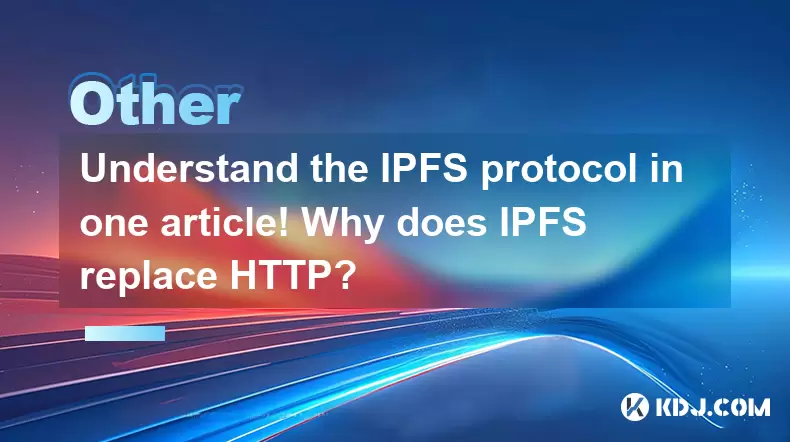
Understand the IPFS protocol in one article! Why does IPFS replace HTTP?
Jun 01,2025 at 06:01pm
The InterPlanetary File System, commonly known as IPFS, is a protocol and network designed to create a more efficient, decentralized, and secure method for storing and sharing files. As the digital world evolves, the traditional HTTP (Hypertext Transfer Protocol) has shown limitations that IPFS aims to address. This article will delve into the intricaci...
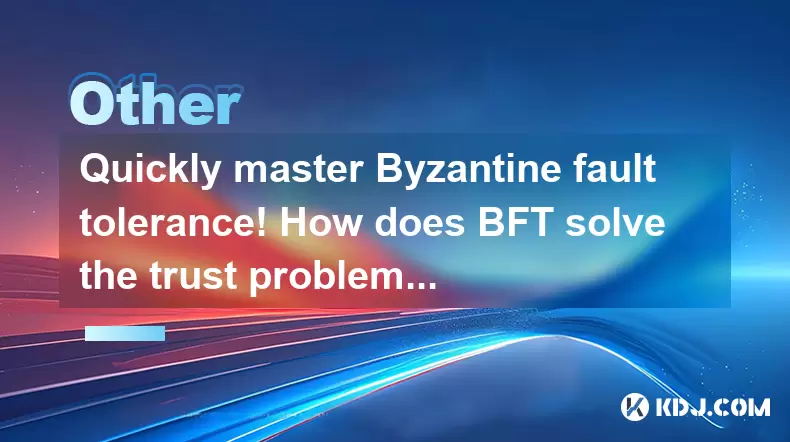
Quickly master Byzantine fault tolerance! How does BFT solve the trust problem?
May 29,2025 at 02:43am
Introduction to Byzantine Fault ToleranceByzantine Fault Tolerance (BFT) is a crucial concept in the field of distributed computing, particularly within the cryptocurrency ecosystem. BFT addresses the challenge of achieving consensus in a network where some nodes might behave maliciously or fail unexpectedly. This article will delve into the mechanisms ...
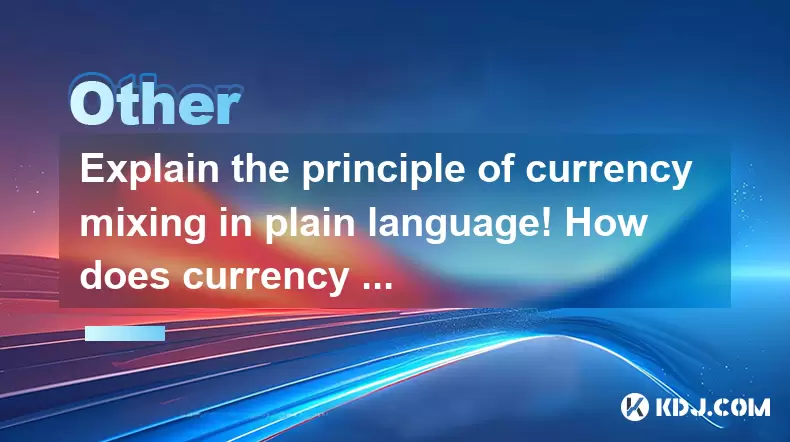
Explain the principle of currency mixing in plain language! How does currency mixing protect privacy?
May 30,2025 at 07:35am
Currency mixing, often referred to as coin mixing or tumbling, is a process used in the cryptocurrency world to enhance privacy and anonymity. The principle behind currency mixing is simple yet effective: it breaks the direct link between the sender and the receiver of cryptocurrencies by mixing multiple transactions together. This makes it difficult fo...
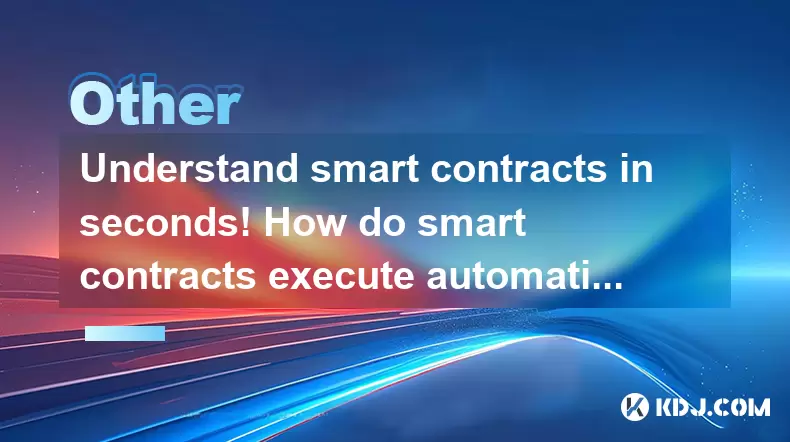
Understand smart contracts in seconds! How do smart contracts execute automatically?
May 30,2025 at 02:43am
Smart contracts have revolutionized the way transactions are executed in the cryptocurrency world. They are self-executing contracts with the terms of the agreement directly written into code. This article will delve into the intricacies of smart contracts and explain how they execute automatically, providing a comprehensive understanding of this ground...
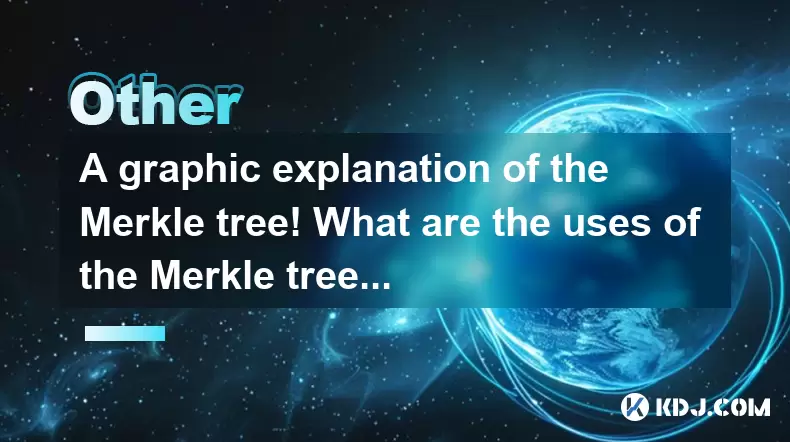
A graphic explanation of the Merkle tree! What are the uses of the Merkle tree?
May 31,2025 at 02:29am
Introduction to the Merkle TreeA Merkle tree, also known as a hash tree, is a fundamental data structure in the world of cryptocurrencies, especially within blockchain technology. It is used to efficiently and securely verify the integrity of large data sets. The concept was first introduced by Ralph Merkle in 1979, and it has since become a cornerstone...
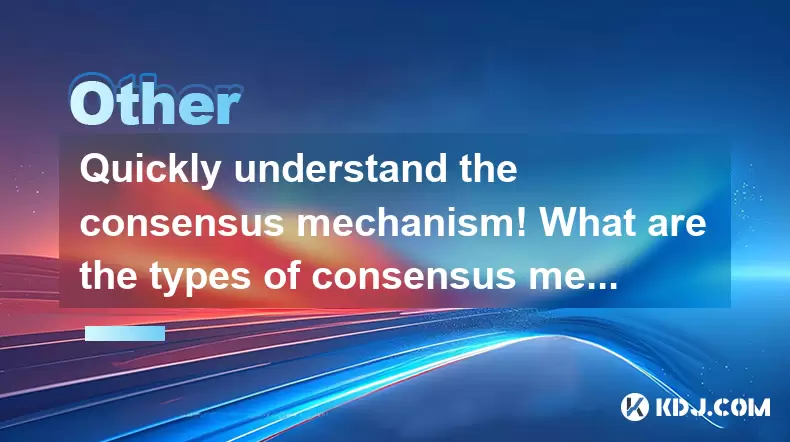
Quickly understand the consensus mechanism! What are the types of consensus mechanisms?
May 30,2025 at 06:07am
Introduction to Consensus MechanismsIn the world of cryptocurrencies, the term consensus mechanism plays a crucial role in ensuring the integrity and security of transactions on a blockchain. A consensus mechanism is a system that enables network participants to agree on the state of the blockchain, thereby validating transactions and adding new blocks....

Understand the IPFS protocol in one article! Why does IPFS replace HTTP?
Jun 01,2025 at 06:01pm
The InterPlanetary File System, commonly known as IPFS, is a protocol and network designed to create a more efficient, decentralized, and secure method for storing and sharing files. As the digital world evolves, the traditional HTTP (Hypertext Transfer Protocol) has shown limitations that IPFS aims to address. This article will delve into the intricaci...

Quickly master Byzantine fault tolerance! How does BFT solve the trust problem?
May 29,2025 at 02:43am
Introduction to Byzantine Fault ToleranceByzantine Fault Tolerance (BFT) is a crucial concept in the field of distributed computing, particularly within the cryptocurrency ecosystem. BFT addresses the challenge of achieving consensus in a network where some nodes might behave maliciously or fail unexpectedly. This article will delve into the mechanisms ...

Explain the principle of currency mixing in plain language! How does currency mixing protect privacy?
May 30,2025 at 07:35am
Currency mixing, often referred to as coin mixing or tumbling, is a process used in the cryptocurrency world to enhance privacy and anonymity. The principle behind currency mixing is simple yet effective: it breaks the direct link between the sender and the receiver of cryptocurrencies by mixing multiple transactions together. This makes it difficult fo...

Understand smart contracts in seconds! How do smart contracts execute automatically?
May 30,2025 at 02:43am
Smart contracts have revolutionized the way transactions are executed in the cryptocurrency world. They are self-executing contracts with the terms of the agreement directly written into code. This article will delve into the intricacies of smart contracts and explain how they execute automatically, providing a comprehensive understanding of this ground...

A graphic explanation of the Merkle tree! What are the uses of the Merkle tree?
May 31,2025 at 02:29am
Introduction to the Merkle TreeA Merkle tree, also known as a hash tree, is a fundamental data structure in the world of cryptocurrencies, especially within blockchain technology. It is used to efficiently and securely verify the integrity of large data sets. The concept was first introduced by Ralph Merkle in 1979, and it has since become a cornerstone...

Quickly understand the consensus mechanism! What are the types of consensus mechanisms?
May 30,2025 at 06:07am
Introduction to Consensus MechanismsIn the world of cryptocurrencies, the term consensus mechanism plays a crucial role in ensuring the integrity and security of transactions on a blockchain. A consensus mechanism is a system that enables network participants to agree on the state of the blockchain, thereby validating transactions and adding new blocks....
See all articles
























